Introduction
The 1970s, when Formula 1 drivers were practically modern-day gladiators, racing in cars that were fast, loud, and, quite frankly, death traps on wheels. The track was their Colosseum, and the spectators came for the crashes just as much as the checkered flags. And right in the thick of it? Two men, as different as oil and water, locked in one of the fiercest rivalries motorsport has ever seen. That’s Rush—the story of James Hunt and Niki Lauda, a pair of drivers who made Formula 1 a sport and a spectacle of speed, ego, and sheer guts.
Directed by Ron Howard, Rush isn’t just another racing movie—it’s an adrenaline-fueled ride through the 1976 Formula 1 season, where two titans of the track battled for the World Championship in a rivalry that defined an era. On one side, you’ve got James Hunt, a playboy with a penchant for living in the fast lane—both on and off the track. On the other, Niki Lauda was a meticulous, disciplined driver who calculated every move with the precision of a Swiss watch. Their personalities clashed like the engines in their cars, and the result? One of the greatest motorsport stories ever told.
Strap in because this isn’t just about racing—obsession, risk, and the price of glory. Let’s dive into Rush and see how the film captures the speed and raw humanity behind one of Formula 1’s most legendary rivalries.
Historical Accuracy
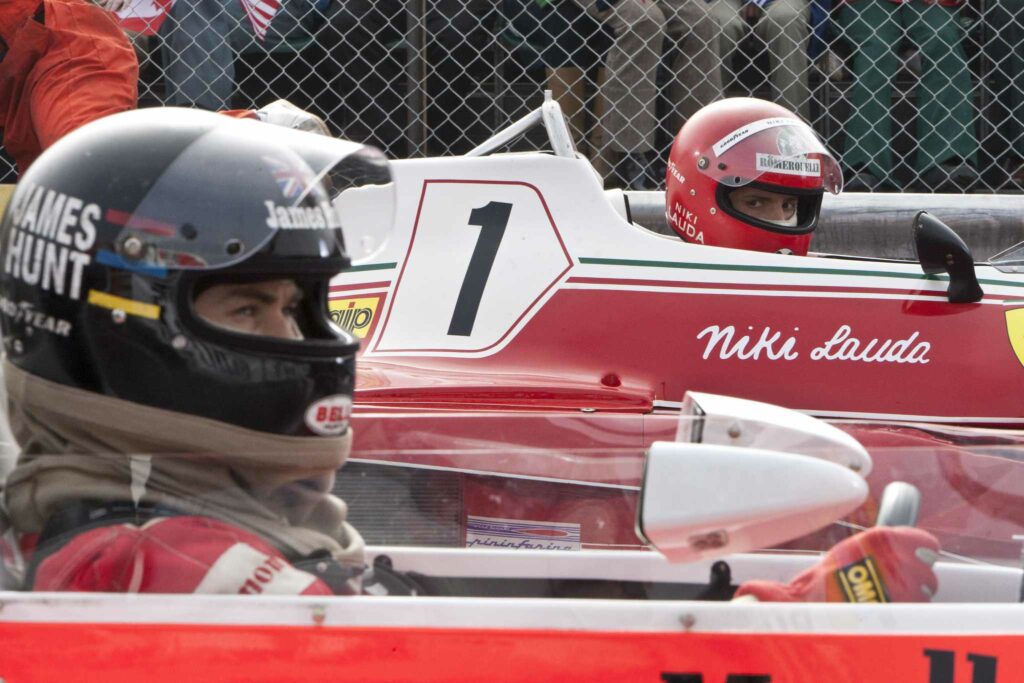
Now, when it comes to racing movies, there’s always a bit of wiggle room with the truth. Let’s be honest—real life isn’t always as cinematic as we’d like. But Rush does a pretty impressive job of sticking close to the events of the 1976 Formula 1 season. Sure, there are a few dramatic flourishes here and there (because what’s a racing movie without a little Hollywood magic?), but the core of the story—the tension, the rivalry, and the drama between Hunt and Lauda—is spot on.
The film introduces us to both drivers in all their glory. Hunt, played by Chris Hemsworth, is the golden boy of British motorsport—handsome, cocky, and living life as fast as he races. Meanwhile, Daniel Brühl’s Niki Lauda is the polar opposite—serious, methodical, and not precisely the life of the party. But that’s the beauty of this rivalry. Hunt’s devil-may-care attitude and Lauda’s precision couldn’t have been more different, and the film captures that contrast brilliantly.
One of the film’s biggest triumphs is showcasing the key moments of the 1976 season, notably Lauda’s horrific crash at the Nürburgring. In reality, Lauda’s Ferrari caught fire after a high-speed collision, leaving him with severe burns that nearly killed him. Miraculously, he returned to the cockpit just six weeks later—an act of sheer will cemented his place in motorsport history. The film doesn’t pull any punches here, giving us an unflinching look at the dangers these drivers faced every time they hit the track.
But Rush isn’t just a movie about crashes and comebacks. It’s about the mental game these drivers played. The tension between Hunt and Lauda is palpable, both on the track and off. Hunt’s wild, unpredictable style put him at odds with Lauda’s cold, calculated approach, and that friction is what makes the film so compelling. There’s a brilliant scene where Lauda, fresh out of the hospital, meets Hunt in the pit lane. It’s a quiet moment, but you can feel the weight of their rivalry pressing down on them. Lauda, still bandaged, is ready to get back behind the wheel, and Hunt can’t help but respect the sheer guts it takes to do that.
The film takes a bit of liberty in dramatizing specific interactions between Hunt and Lauda. The two were fierce competitors in real life, but there was also a mutual respect that doesn’t always come through in the more heated exchanges on screen. This is a movie, not a documentary, and if it amps up the drama a little for the sake of storytelling, we’re not complaining.
Ultimately, Rush captures the essence of the Hunt-Lauda rivalry with a balance of accuracy and cinematic flair. The cars, the tracks, the atmosphere of 1970s Formula 1—it’s all there and feels authentic. For motorsport fans, the film offers a thrilling retelling of one of the greatest seasons in F1 history, with just enough dramatic spice to keep even the most casual viewer on the edge of their seat.
Performances
Let’s be honest—there’s no shortage of testosterone in Rush, and the two lead actors, Chris Hemsworth and Daniel Brühl, bring the heat in a way that makes you feel like you’re standing right there on the starting grid, watching two gladiators prepare for battle.
As James Hunt, Hemsworth is every bit the dashing, reckless playboy you’d expect. Hemsworth’s golden locks, charming smile, and devil-may-care attitude oozes charisma from the moment he steps on screen. He plays Hunt not just as a driver but as a man addicted to the thrill—whether it’s the rush of racing or the high life off the track. And while Hemsworth certainly looks the part, his ability to dig into Hunt’s insecurities really sells the performance. Beneath all that bravado, a man knows that every race could be his last, and that sense of danger follows him like a shadow. Hemsworth captures Hunt’s highs and lows beautifully—one minute, he’s the life of the party; the next, he’s drowning in the pressure of living up to his legend.
Then you’ve got Daniel Brühl as Niki Lauda; honestly, the guy is a revelation. If Hemsworth’s Hunt is all flash and chaos, Brühl’s Lauda is the exact opposite—controlled, analytical, and relentlessly focused. You can feel Lauda’s intensity from the moment Brühl steps onto the screen. He’s not in this for fame or glory—he’s here to win and is willing to do whatever it takes to get that championship trophy. Brühl’s performance is understated but powerful. He nails Lauda’s quiet determination, bluntness, and ruthless drive to be the best, even if it alienates those around him.
The magic of Rush comes from how these two performances play off each other. Hunt and Lauda were more than rivals—they were foils, each representing a different approach to racing and life. Hemsworth and Brühl embody that contrast with incredible chemistry. Every scene between them crackles with tension, whether they’re trading barbs in the press or glaring at each other from across the pit lane.
There’s a great scene where Lauda, still recovering from his horrific crash at the Nürburgring, watches Hunt win a race. You can see the mixture of respect and jealousy simmering beneath Brühl’s calm exterior, while Hemsworth’s Hunt revels in the victory, knowing that his rival is down but not out. These quieter moments, where neither of them is behind the wheel, highlight the depth of their performances. Both actors manage to convey so much with just a look—a raised eyebrow here, a clenched jaw there—that you forget you’re watching a film. It feels like you’re watching history unfold in real time.
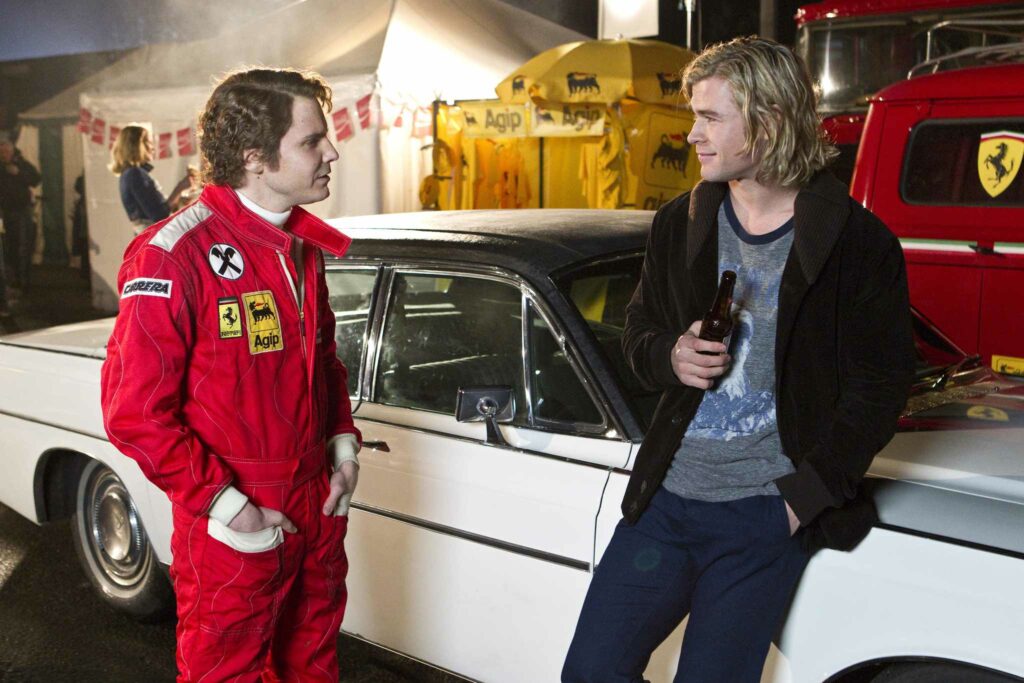
What’s particularly impressive is how both actors handle the physicality of their roles. Racing in the 1970s wasn’t just about skill—it was about mental and physical endurance. Hemsworth and Brühl capture the wear and tear of the sport, from the gruelling preparation to the sheer exhaustion after a race. Brühl especially deserves praise for his portrayal of Lauda’s recovery from the Nürburgring crash. The makeup is fantastic, but it’s Brühl’s performance that sells the pain, the fear, and the determination to get back in the driver’s seat just weeks after being pulled from a burning car.
Let’s not forget the supporting cast. Olivia Wilde shines as Suzy Miller, Hunt’s glamorous wife, gives us a glimpse into the chaotic personal life of a man who was as unpredictable off the track as he was on it. Meanwhile, Alexandra Maria Lara plays Marlene Lauda, Niki’s wife, with a quiet strength that perfectly reinforces Brühl’s intensity. Both women add emotional depth to the film, grounding the story in the natural consequences of living at 200 mph.
In conclusion, the performances in Rush are nothing short of spectacular. Hemsworth and Brühl don’t just play Hunt and Lauda—they become them, bringing to life one of motorsport’s greatest rivalries with passion, intensity, and a surprising heart. Whether you’re a die-hard Formula 1 fan or just someone who loves a good underdog story, the performances alone are enough to keep you hooked from start to finish.
Cinematography and Visual Style
If there’s one thing Rush absolutely nails, it’s the visual experience of Formula 1 racing in the 1970s. From the moment the engines roar to life, you’re not just watching a race—you’re in it. Director Ron Howard and cinematographer Anthony Dod Mantle use every trick in the book to make you feel like you’re sitting right behind the wheel, hurtling through the narrow, dangerous circuits at breakneck speeds.
The racing sequences are a masterclass in how to capture speed on film. The camera doesn’t just follow the cars from a safe distance. It dives into the action, almost becoming another racer on the track. Close-up shots of the drivers’ faces, covered in sweat and grim determination, are interspersed with wide-angle shots of cars zipping down straights or battling through hairpin turns. The quick cuts, the low angles that make the cars seem like they’re flying inches from the ground, and the tight shots of tyres screaming for grip work together to immerse you fully in the race.
What sets Rush apart visually is how it contrasts the different racing styles of Hunt and Lauda. For Hunt, the cinematography mirrors his chaotic, seat-of-the-pants driving style. The camera moves with jittery energy, swinging wide during overtakes and vibrating with the car as it bounces over curbs. It’s all about capturing the sheer adrenaline that Hunt thrived on. You feel the weight of his wild, aggressive approach, and it’s exhilarating.
Lauda’s scenes, on the other hand, are much more controlled. The shots are tighter, the movements smoother, reflecting his calculated, precision-driven racing style. The camera lingers on his focus, the tiny adjustments he makes mid-race, and the efficiency of his driving. In the same way that Lauda meticulously managed every corner and every pit stop, the cinematography feels more deliberate when he’s in the cockpit. It’s brilliant to use visual language to show how different these two drivers were, even when chasing the same goal.
The film’s use of light and colour also deserves special mention. The 1970s were an era of bright colours and sharp contrasts, and the film embraces that aesthetic fully. The cars themselves are like speeding works of art, gleaming red Ferraris and brilliant blue McLarens popping off the screen against the asphalt and grassy green of the circuits. And then there’s the sunlight—Howard and Mantle use natural light to stunning effect, whether it’s the early morning sun glinting off a car’s windshield as it lines up on the grid or the long shadows that stretch across the track during a late afternoon race. This use of light gives the film a nostalgic, almost dreamlike quality, reminding us that this was an era when racing felt raw and honest.
One of the most striking visual sequences comes during Lauda’s near-fatal crash at the Nürburgring. The film doesn’t shy away from the horror of the accident, and the way it’s shot pulls you in close. The camera spins and blurs as Lauda’s Ferrari slams into the wall, the flames roaring up around him. It’s disorienting and terrifying, exactly how you’d imagine such a crash would feel from inside the car. The scene is followed by a haunting series of shots showing the aftermath, with slow-motion flames licking at the car’s remains and Lauda being pulled from the wreckage. The juxtaposition of chaos and stillness in this sequence is gut-wrenching, and it’s one of the most visually powerful moments in the film.
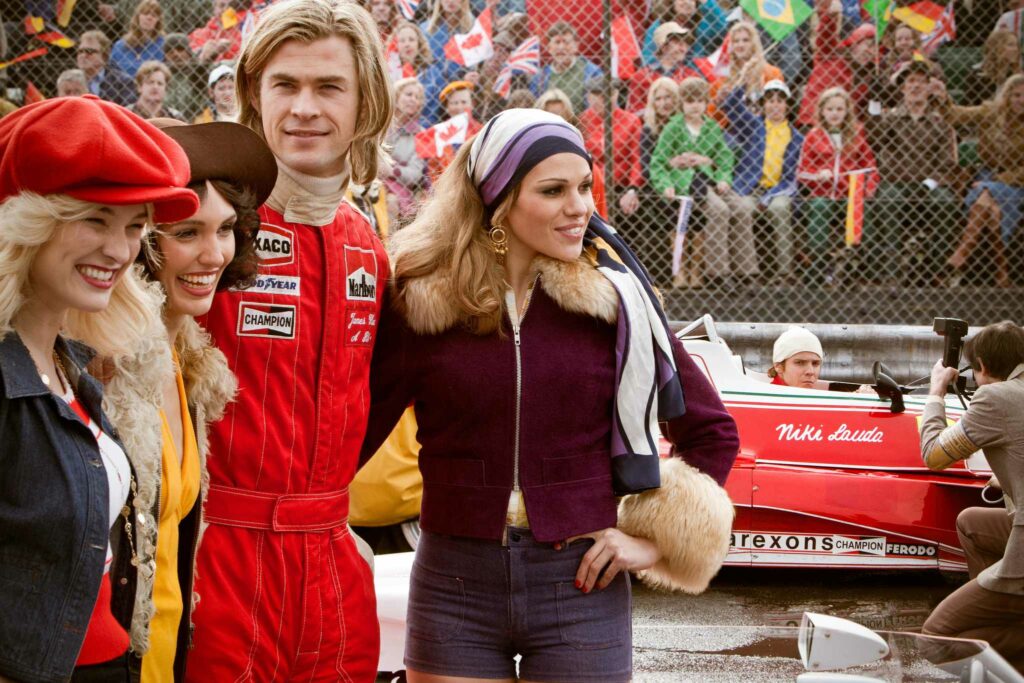
But Rush isn’t just about the races. Off the track, the visual style shifts to reflect the drivers’ personal lives. Hunt’s world is one of parties, glitzy locations, and fast women, and the camera captures this hedonistic lifestyle with broad, sweeping shots of glamorous locations and slow-motion sequences of champagne-soaked celebrations. Lauda’s life, by contrast, is portrayed with more restraint. The shots are often tighter, the colours more muted, reflecting his no-nonsense approach to life and racing. This visual contrast adds another layer to the story, highlighting the differences between the two men in their racing and how they lived their lives.
The racing circuits themselves are also characters in the film. Each track has its personality, and the cinematography captures the uniqueness of each location. Whether it’s the narrow, twisting streets of Monaco or the open, high-speed straights of Silverstone, you get a real sense of the challenge each track poses to the drivers. The camera moves fluidly, allowing the audience to appreciate the artistry and difficulty of mastering these circuits. And when the weather turns—whether it’s rain pelting down or fog rolling in—you feel the added danger these unpredictable conditions bring to the race.
In conclusion, Rush is a visual feast, especially for motorsport fans. The cinematography brings the danger, speed, and beauty of Formula 1 to life in a way that few films ever have. Whether watching a race unfold in the heat of competition or catching a quiet moment of reflection in the pits, the film’s visual style draws you in and doesn’t let go. It’s fast, intense, and, most importantly, natural. If you’ve ever wondered what it’s like to be behind the wheel of a Formula 1 car, Rush gives you a front-row seat to the action—without the risk of catching fire.
Direction and Screenplay
In a rush, Ron Howard delivers one of his career’s most exciting and emotionally charged films. Known for his ability to balance character-driven drama with blockbuster appeal, Howard’s direction in Rush captures not only the high-octane world of Formula 1 but also the deep, personal rivalry between James Hunt and Niki Lauda. It’s not just a racing movie—it’s a story about what it means to live on the edge, both in and out of the driver’s seat.
Howard doesn’t treat the film as a series of races strung together. Instead, he builds tension through the narrative, carefully crafting moments of intensity both on and off the track. Each race becomes more than just a contest of speed; it reflects the drivers’ struggles, ambitions, and insecurities. The way Howard weaves these races into the larger story of Hunt and Lauda’s rivalry makes Rush feel like more than just a sports biopic—it’s a character study wrapped in burning rubber.
What Howard does particularly well is pacing. The film keeps moving but knows when to take its foot off the gas to let the characters breathe. Racing movies can sometimes get bogged down in endless action, but Rush avoids that trap. For every white-knuckled race sequence, there’s a quieter moment where we see what’s at stake for these drivers on a personal level. Whether it’s Hunt drowning in self-doubt after a loss or Lauda facing the terrifying possibility that he might never race again, these scenes give the film an emotional depth that keeps you invested in the characters as much as the races themselves.
One of the film’s standout moments in direction comes during Lauda’s recovery after his crash at the Nürburgring. Howard doesn’t shy away from showing the physical and emotional toll of Lauda’s injuries. The hospital scenes are brutal, with close-ups of Lauda’s burned face and the painful procedures he has to endure. But Howard never lets the film feel like it’s exploiting the injury for shock value. Instead, he focuses on Lauda’s determination to return to racing, using long, tense shots to show his inner struggle as he watches races from his hospital bed. It’s a masterclass in how to build empathy without slipping into melodrama.
The screenplay by Peter Morgan (who also wrote Frost/Nixon and The Queen) is sharp and precise, much like Lauda’s driving style. Morgan excels at writing about real-life figures, bringing that expertise to Rush. The dialogue crackles with wit, especially in the exchanges between Hunt and Lauda, where their mutual respect and disdain play out in every barb and quip. Morgan takes two very different personalities and makes both compelling, ensuring you’re never quite sure who you’re rooting for more.
The screenplay does a great job of not leaning too heavily into the usual sports movie clichés. Yes, it’s a classic underdog story in some ways, but it’s more complex than that. Hunt and Lauda aren’t simply cast as heroes and villains. Instead, they’re presented as two sides of the same coin—both driven by the same desire to win but with entirely different approaches to life and racing. Morgan’s script gives equal weight to their successes and failures, showing that in the high-stakes world of Formula 1, the line between heroism and self-destruction is razor-thin.

The film’s dialogue is another highlight. Hunt’s lines are full of bravado and swagger, reflecting his devil-may-care attitude. Whether he’s trash-talking Lauda or charming a room full of reporters, every word feels like it’s coming from someone who’s always living in the moment. Lauda, by contrast, speaks with a sharp, matter-of-fact tone. His words are calculated, like his driving. When Lauda delivers a line, it hits like a perfectly timed punch, cutting through the noise with brutal honesty. There’s one particularly memorable scene where Lauda, after his crash, tells his doctors, “I accept every time I get in my car that there’s a 20% chance I might die, but I can live with that.” It’s a line that perfectly sums up Lauda’s philosophy—cold, clinical, and fearless.
The screenplay also excels in capturing the evolution of the Hunt-Lauda relationship. At the film’s beginning, it’s clear these two are rivals, but as the story unfolds, you see glimpses of mutual respect and admiration. The film doesn’t beat you over the head, but you feel the weight of their shared history by the final race. It’s no longer just about winning a championship—it’s about the personal battles they’ve both fought and how they’ve pushed each other to be better, whether they’d admit it or not.
Ron Howard’s direction and Peter Morgan’s screenplay create a film that’s not just a thrilling ride but a profoundly human story about two men willing to risk everything to be the best. They didn’t just compete—they drove each other to the limits of what was possible in the car and life. And that’s what makes Rushmore more than just another racing movie. It’s a story of rivalry, respect, and the dangerous allure of living in the fast lane.
In conclusion, the direction and screenplay of Rush strike the perfect balance between heart-pounding racing action and personal drama that makes the story resonate on a deeper level. Howard’s ability to keep the tension high while giving the characters room to breathe, combined with Morgan’s sharp, character-driven script, makes Rush a film that appeals to racing fans and anyone who loves a good underdog story. It’s a thrilling, emotional ride from start to finish.
Sound Design and Music
If you thought the visuals in Rush were impressive, wait until you hear the sound. The roar of a Formula 1 engine is a symphony for petrolheads, and Rush turns that into a visceral, cinematic experience. From the growl of the engines to the screech of tyres struggling for grip, the sound design in this film is nothing short of exhilarating. It doesn’t just capture the noise of the races—it makes you feel the power, the speed, and the sheer danger of 1970s Formula 1.
The film’s sound design does something critical: it turns each race into an immersive, heart-pounding experience. Every engine rev, every gear shift, and every screech as the tyres fight against the track feels like it’s happening right next to you. Whether you’re watching Hunt tear down a straightaway in his McLaren or Lauda carve his way through a tight corner, the sound puts you in the driver’s seat. You can practically hear the car straining under the immense power, ready to explode into action with every tap of the throttle.
One of the most brilliant aspects of the sound design is how it reflects the personalities of Hunt and Lauda through their cars. Hunt’s McLaren has a wild, ferocious roar that mirrors his untamed driving style, while Lauda’s Ferrari purrs with a more controlled, organized sound, reflecting his precision on the track. The difference in the soundscapes adds another layer to their rivalry—it’s not just about who drives faster, but how they drive and how their machines reflect their philosophies.
The racing scenes, especially, are a treat for the ears. The film’s sound team paid incredible attention to detail, capturing the subtle differences between various engines and the sounds of different tracks. The thundering echoes as the cars race through narrow city streets are distinctly different from the open, wind-swept sounds of a race in Monza. These changes make each race feel unique and immersive, pulling you into the distinct atmosphere of every circuit.
But it’s not all about loud engines and screeching tyres. The film also uses silence—yes, silence—to significant effect. In moments of extreme tension, the sound fades away, leaving only the pulse of the drivers’ breaths and the pounding of their hearts. One such moment comes during the lead-up to Lauda’s crash at the Nürburgring. As his car hurtles toward disaster, the sound almost disappears, replaced by a tense, barely-there hum that mirrors Lauda’s creeping realisation that something’s about to go very wrong. When the crash finally happens, the sound explodes back into the scene with brutal intensity, driving home the sheer violence of the impact.
And then there’s the score. Composed by Hans Zimmer, the music in Rush perfectly complements the intensity of the racing action and the emotional weight of the characters’ journeys. Zimmer, known for his epic, sweeping soundtracks in films like Inception and Gladiator, takes a slightly different approach here. While there are still moments of grandeur, much of the score is more subtle, reflecting the personal stakes at play.
During the racing sequences, Zimmer amps up the energy with pulsating rhythms and rising tension, making you feel strapped into the car as it hurtles around the track. The music isn’t overbearing—it knows when to step back and let the sound of the vehicles take centre stage. But when the races get incredibly tight, Zimmer’s score creeps in, ramping up the excitement until you can’t help but hold your breath for the final lap.
What’s particularly compelling is how Zimmer uses music to highlight the emotional journey of the drivers. The score is often more restrained for Lauda, matching his focused, almost clinical approach to racing. But in moments of vulnerability—such as his recovery after the crash—the music becomes more tender, reflecting the human cost of his obsession with winning. The music is often more wild and frenetic for Hunt, especially during his off-track antics. But as the film progresses and the weight of his rivalry with Lauda begins to take its toll, the score shifts, becoming more sombre and reflective.
One of the standout musical moments comes in the final race of the 1976 season, where Hunt and Lauda face off in the rain-soaked Japanese Grand Prix. As the race unfolds, Zimmer’s score rises and falls with the drama, capturing the tension of the showdown between these two titans of the sport. The music here isn’t just a backdrop—it’s a driving force, pulling you deeper into the race and heightening the stakes with every lap.
In conclusion, Rush’s sound design and music are as essential to the film’s success as its acting and visuals. The roaring engines, screeching tyres, and heart-pounding crashes are brought to life with incredible detail, making every race feel like an immersive experience. With Hans Zimmer’s powerful score underpinning the emotional and physical stakes of the story, Rush’s soundscape becomes a key player in bringing this legendary rivalry to the screen. Whether you’re a Formula 1 fanatic or just someone who loves a great movie soundtrack, the sound in Rush is something to behold.
Themes and Emotional Impact
At the heart of Rush, beyond the screeching tyres and roaring engines, are the universal themes of rivalry, obsession, and the fine line between life and death. The film isn’t just about who crosses the finish line first—it’s about what it takes to get there. Director Ron Howard weaves these themes throughout the story, using the intense rivalry between James Hunt and Niki Lauda as a lens through which we can examine the deeper emotional currents that drive both men to risk everything for victory.
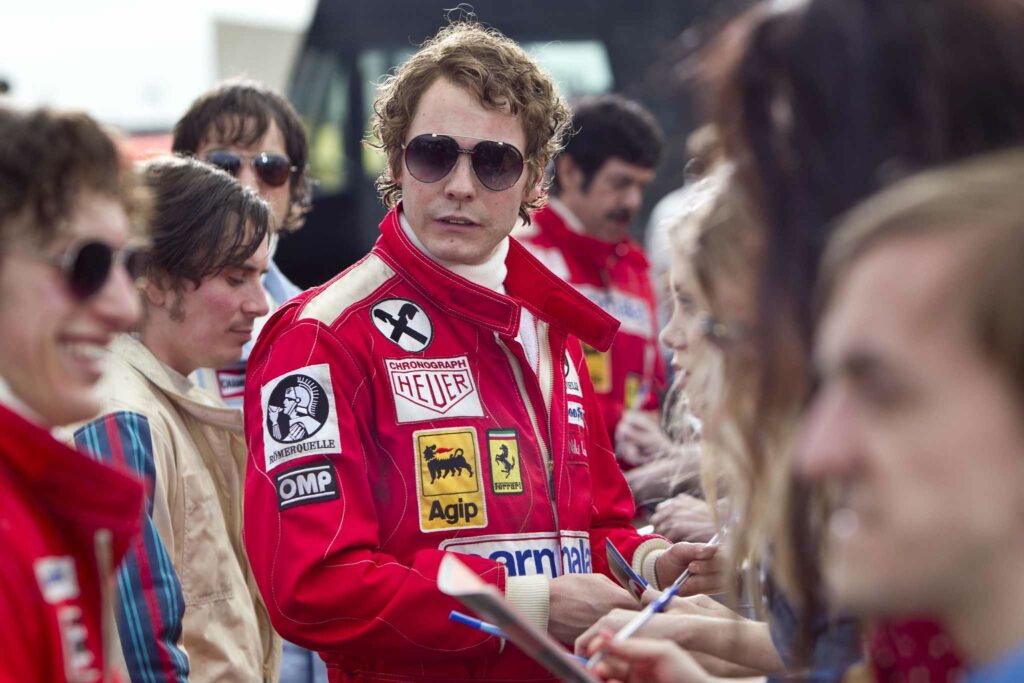
One of the film’s most potent themes is the cost of obsession. For both Hunt and Lauda, Formula 1 racing isn’t just a sport—it’s a calling, an obsession that pushes them to the edge of human endurance. Lauda’s meticulous, almost surgical approach to racing is driven by his need to be the best and control every aspect of his performance, both on and off the track. His obsession with perfection makes him so successful, but it also isolates him from others. He lives by a strict code, sacrificing personal relationships and comfort to pursue victory. This is most evident in the scenes where Lauda recovers from his horrific accident. Despite being told he may never race again, Lauda is back on the track within weeks, pushing his body to the limit in pursuing his obsession.
In contrast, Hunt’s obsession is less about control and more about the thrill. He races for the adrenaline, the fame, and the sheer joy of it. But as the film progresses, we see how this carefree attitude masks a more profound need for validation. Hunt’s obsession with winning isn’t as systematic as Lauda’s, but it’s no less intense. The film explores how his reckless approach to racing and life eventually catches up with him, leaving him emotionally and physically drained. The toll that Formula 1 takes on Hunt is captured in moments of vulnerability, particularly in scenes where his personal life begins to unravel. The film cleverly contrasts Hunt’s and Lauda’s obsessions to show that the road to the top is paved with sacrifices, whether you’re a perfectionist or a thrill-seeker like Hunt.
Rivalry is another central theme of Rush, but it’s not a simplistic “good guy versus bad guy” narrative. Instead, the film shows how rivalry can be both destructive and inspiring. Hunt and Lauda push each other to their absolute limits, and while their competition is fierce, it’s also what drives them to be better. The rivalry between them is more than just a fight for the championship—it’s a clash of philosophies, personalities, and egos. Lauda’s cold precision versus Hunt’s raw talent creates a dynamic that’s not just thrilling to watch but also deeply personal. The film also doesn’t shy away from showing how this rivalry impacts their lives off the track. Lauda’s bitterness toward Hunt after his accident is palpable, but the rivalry becomes more complex as the season progresses—a grudging respect.
The beauty of Rush is that it portrays the rivalry between Hunt and Lauda as a relationship that ultimately defines both men. They need each other, even if they don’t want to admit it. Without Hunt, Lauda’s racing would lack the chaos and unpredictability that forces him to adapt and improve. Without Lauda, Hunt’s recklessness would have no real challenge against which to test it. The film’s final moments, where Lauda reflects on Hunt’s career after his win in Japan, reveal the deep, unspoken bond between the two. It’s a rivalry that transcends mere competition—it’s about pushing each other to greatness.
Risk and mortality are ever-present themes in Rush. Formula 1 in the 1970s was hazardous, and the film captures the constant threat of death that looms over every race. The drivers, the teams, and the fans are acutely aware that every time a driver gets into the car, it might be the last time. This theme is most powerfully explored in Lauda’s crash at the Nürburgring, a scene that forces the audience to confront the genuine dangers of the sport. The film doesn’t glamorise the collision—it presents it with raw, brutal honesty, showing the devastating physical and emotional consequences for Lauda.
Lauda’s recovery is where the theme of risk truly hits home. His decision to return to racing so soon after his accident isn’t just about winning—it’s about facing death and proving that he’s still in control. It’s a stark reminder that, for these drivers, racing is about more than glory—it’s about defying the odds, staring death in the face, and pushing through. Hunt, too, wrestles with this theme, though in a more subtle way. As the season progresses and the pressure mounts, Hunt realises that his risks aren’t just physical but emotional. His carefree attitude begins to crack, revealing the psychological toll of constantly teetering on the edge of disaster.
Finally, Rush explores the theme of respect—not just between Hunt and Lauda, but between the drivers and the sport itself. Racing isn’t just a job for these men; it’s a way of life, a calling that demands total commitment. The film shows how, despite their differences, Hunt and Lauda deeply respect the sport and what it requires of them. This respect ultimately leads to the film’s emotional climax, where Lauda, having survived one of the most terrifying crashes in Formula 1 history, chooses to walk away from the final race in Japan. At the same time, Hunt pushes forward, winning the championship. It’s a moment that defines both men—Lauda, the pragmatist, understands that sometimes walking away is the braver choice, while Hunt, the risk-taker, knows that he has to seize the moment, even if it means flirting with disaster.
In conclusion, Rush is more than just a racing film—it’s a story about ambition, rivalry, and the price of greatness. The themes of obsession, respect, and mortality are woven through every scene, giving the film an emotional weight that resonates long after the credits roll. For Hunt and Lauda, racing wasn’t just about winning—it was about defining themselves, testing their limits, and ultimately, finding respect in their fiercest competitor’s eyes. It’s a film that reminds us that the most significant rivalries aren’t just about who wins—they’re about how far you’re willing to go to reach the finish line.
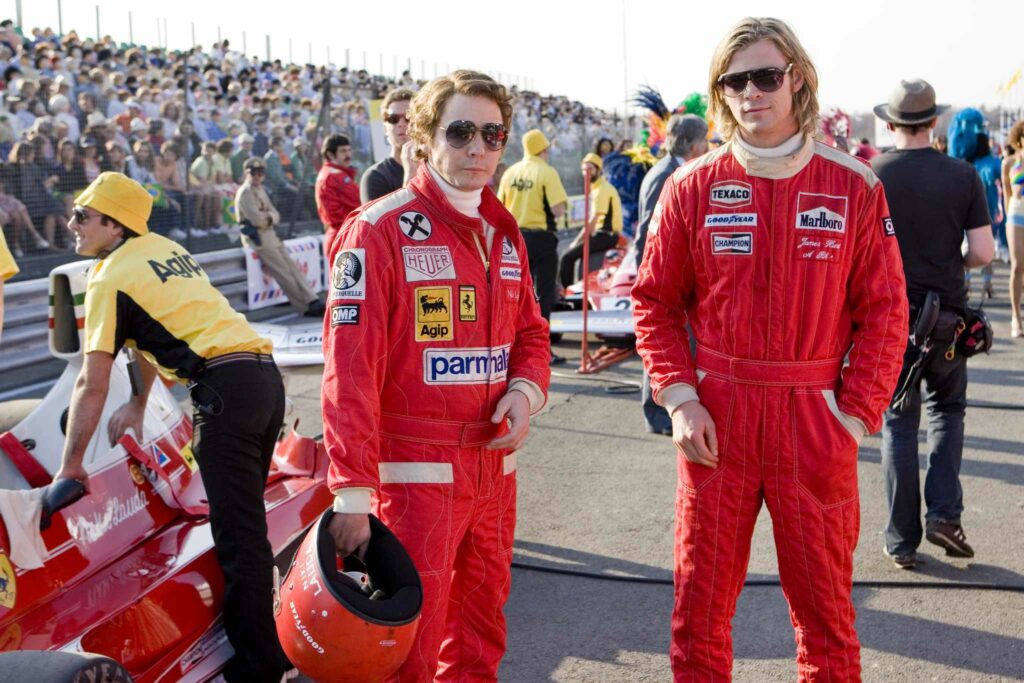
Reception and Legacy
When Rush hit the screens in 2013, it was more than just a film for motorsport fans—it became a cultural touchstone for its dramatic storytelling, dynamic performances, and thrilling depiction of one of the greatest rivalries in sports history. Both critics and audiences quickly praised its gripping narrative, stunning visuals, and how it captured the true essence of Formula 1 in the 1970s. But what about Rush left such a lasting impact, and how does the film stand in the pantheon of motorsport movies?
Critical Reception
From the moment Rush premiered, it was clear that the film was unique. Critics praised Ron Howard for delivering a racing movie that wasn’t just about speed and crashes but about people—real, flawed, fascinating individuals whose passion for racing drove them to incredible heights. The film’s balance between action-packed racing scenes and the personal drama of Hunt and Lauda’s rivalry struck a chord, with reviewers noting how it transcended the typical sports movie formula.
Chris Hemsworth and Daniel Brühl received widespread acclaim for their James Hunt and Niki Lauda portrayals. While Hemsworth brought Hunt’s playboy charm and reckless confidence to life, Brühl’s portrayal of Lauda really stole the show for many critics. Brühl’s ability to embody Lauda’s meticulous, no-nonsense attitude while revealing his vulnerability earned him a BAFTA nomination for Best Supporting Actor. Many felt that Brühl captured the complexity of Lauda’s character with such nuance that he became the film’s emotional anchor.
The film’s cinematography and race sequences were also highlighted as standout elements. Critics loved how the racing scenes put the audience in the driver’s seat, making them feel the intense speeds, the bone-rattling vibrations, and the looming danger at every corner. The sound design and Hans Zimmer’s score were frequently mentioned as critical factors in heightening the tension and excitement during the races, ensuring that even those who didn’t know much about Formula 1 could feel the stakes in every lap.
Audience Response
While the critical reception was strong, Rush also found a dedicated fanbase among general moviegoers and motorsport fans. For Formula 1 enthusiasts, Rush was a dream come true—a film that respected the sport, treated its history with care, and brought the excitement of 1970s racing to life in a way that felt both authentic and cinematic. Many fans of the sport praised the film’s attention to detail, particularly in its recreation of iconic races and cars and the overall atmosphere of the era.
For audiences unfamiliar with Formula 1, Rush succeeded by focusing on the human drama at the heart of the story. The rivalry between Hunt and Lauda was so different in personality and approach that it created a compelling narrative that drew viewers in, even if they didn’t know a pit stop from a podium finish. The film’s emotional depth and action-packed racing scenes made it accessible to a broader audience, many of whom left the theatre with a newfound appreciation for motorsport and its larger-than-life characters.
Comparisons to Other Motorsport Films
Regarding motorsport movies, Rush is often compared to classics like Ford v Ferrari and Senna. While each film covers a different aspect of racing, Rush is one of the definitive films about Formula 1. Unlike documentaries like Senna, which focuses on real-life footage and interviews, Rush uses the full power of narrative filmmaking to bring its story to life, blending fact and drama in a way that feels thrilling without sacrificing historical accuracy.
In many ways, Rush helped pave the way for films like Ford v Ferrari, which similarly balanced high-stakes racing with the personal stories of its main characters. However, where Ford v Ferrari focuses more on the technical aspects of car development, Rush places its emphasis on the rivalry between the two drivers and how their philosophies about racing shaped their careers. For this reason, Rush stands apart as a film that captures the sport of Formula 1 and explores the psychology of competition at the highest level.
Legacy and Impact
Since its release, Rush has earned a place in the pantheon of great sports films, particularly among motorsport fans. The film has reignited interest in Formula 1, especially in the United States, where the sport has traditionally struggled to gain a foothold. After the film’s release, many fans noted an uptick in interest in Formula 1 races, with new viewers curious about the sport and its rich history.
For James Hunt and Niki Lauda’s legacies, Rush served as a reminder of the extraordinary 1976 season and the unique bond between these two legendary drivers. While they were fierce competitors on the track, their respect for each other grew over time, and the film’s portrayal of this evolving relationship has helped cement their status as two of the most significant figures in motorsport history. For many younger fans who didn’t experience the 1970s racing scene firsthand, Rush introduced them to this iconic rivalry and the larger-than-life personalities who shaped it.
Beyond its impact on motorsport culture, Rush also stands as a prime example of how to make a sports movie that appeals to both fans and non-fans alike. By focusing on the personal stakes and emotional drama behind the races, the film transcends the genre, offering a story that’s not just about cars but about the human drive to succeed, no matter the cost.
Conclusion
In the end, Rush is more than just a movie about racing—it’s about rivalry, respect, and the extraordinary lengths people will go to to prove themselves. The critical acclaim, combined with its widespread appeal among audiences, has ensured that Rush will be remembered not just as an excellent motorsport film but as a great film. It’s a film that captures the thrill of speed, the danger of competition, and the complex, often fragile egos that drive us all. And for anyone who’s ever pushed themselves to the limit, whether in a race car or life, Rush is a reminder that the journey to the finish line is often as important as the victory itself.


